#and finally: chaco canyon
Explore tagged Tumblr posts
Text
Preliminaries: Battle of the Black-on-Whites!
Black-on-white pottery is far and away the most common decorated pottery style of the ancient Southwest. There are way, way too many to include them all... in fact, there are too many to include even all the ones I want to show off!
So this is the Preliminary Round - four different black-on-white types will go up against each other... only two will move on to represent black-on-whites in the final bracket.

Vote for your favorite!
Information and details about each type under the cut:
Sosi and Dogoszhi Black-on-white
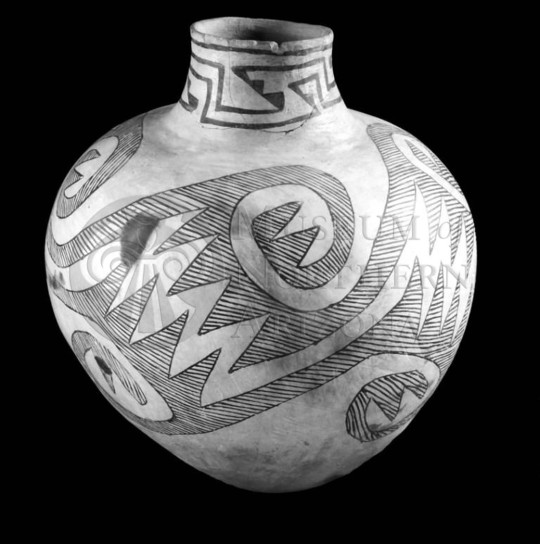
Dogoszhi Black-on-white jar. Northeastern Arizona, 1050-1200.
These are actually two different types within Tusayan White Ware - Sosi B/W and Dogoszhi B/W. However, like I said, Too Many Whitewares, so I'm grouping them together because there's strong overlap.
Sosi B/W can be identified by its bold, black designs, like the one in the compilation above the cut; Dogozshi B/W has similar design layout, but instead of solid black, they're filled with hatchure (thin, parallel lines. Sometimes, like the image above, the body is a Dogoszhi design, while the neck has a more Sosi-like design.
Sosi and Dogozshi Black-on-whites were built with the coil-and-scrape method (built up of many small coils, probably turned on a turning plate called a puki, and then while the clay was still wet, scraped smooth and sometimes polished). The paint was carbon-based and got its color from a plant called beeweed. These were made in the Kayenta and Tusayan regions of north-eastern Arizona.
Mimbres Black-on-white
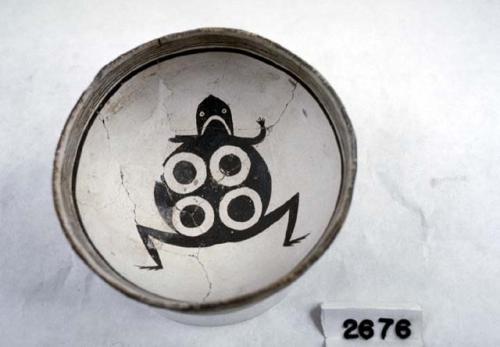
Bowl with a Frog, Mimbres Black-on-white. Southwestern New Mexico, AD 1000-1150.
One of the most iconic Southwest pottery types. Literally: one of the few pottery types in the Southwest to display a wide range of icons, human and animal figures. Pre-Classic Mimbres bowls used geometric and rotational symmetry designs more often, mixing bold lines and hatchure; Classic Mimbres bowls tend to have a linear design around the rim, and then a human or animal design on the inside. Various types of figures are seen, but primarily birds, insects, amphibians/reptiles, and twin human figures, in hematite-based paint.
Mimbres bowls are among the most popular to be sold by looters on the black market. Worse, a very large number of the most dramatic Mimbres bowls come from burials; if you see an archaeological pot for sale with an animal design like this, it was almost certainly stolen out of a grave. You can especially suspect this when the bowls have small circular holes smashed or drilled in the center, usually obscuring the figure partially. Archaeologists call these kill holes, from the idea that the pot was "killed" to end its use-life when it was buried with the deceased person. If you see a Mimbres pot with a kill-hole, odds are very good (something like 80%) that it came from a burial. These displayed bowls here are verified to come from non-burial contexts.
Chaco Black-on-white
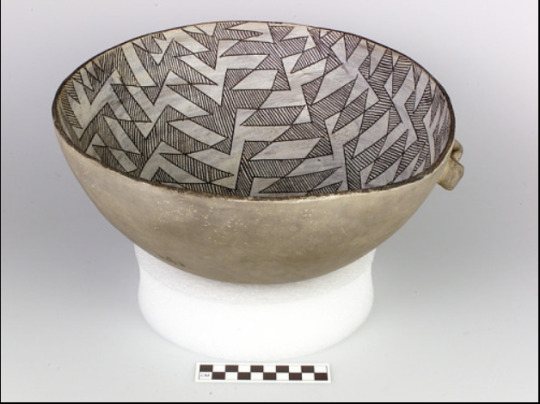
Chaco (or Gallup) Black-on-white. Pueblo Bonito, Chaco Canyon, north-western New Mexico, AD 1000-1100.
Chaco Canyon! One of the most dramatic, interesting, and still mysterious aspects of the Ancestral Southwest. In a canyon in New Mexico, multiple palatial "Great Houses" were built, with hundreds of rooms, large and regimented plazas, massive kivas (circular subterranean religious buildings), and an incredible amount of decoration and pageantry. Pueblo Bonito, the largest of the Chaco Great Houses, is proven to have had a matrilineal elite/noble lineage. How many people actually lived in the Great Houses? Were they palaces, communal centers, worship centers? Were the Chaco elite a priestly class or a noble caste or a bit of both? How did they mobilize people throughout the Chaco sphere of influence to bring timbers down from the mountains a hundred kilometers away to build these Great Houses? There are a lot of things archaeologists still argue about. Pueblo and Navajo oral histories describe Chaco as an overreach of power that their ancestors eventually rejected, leading to the collapse of Chaco Canyon as a center of social influence throughout the Southwest around 1100. (Modern Pueblo and Navajo relationships to Chaco are complicated. It was an overreach of power, but also an incredible ancestral polity.) Until then, it was certainly a socially, politically, and religiously powerful force.
You can also see this in the pottery: this style of hatchure, the narrow black-and-white lines, was massively popular in Chaco Canyon and seems to have kind of ripple-effected out to the rest of the Southwest who were in or near the Chaco sphere of influence. Hatchure is very common in a lot of black-on-white wares, but very close, very narrow, very even hatchure is strongly associated with Chaco Canyon.
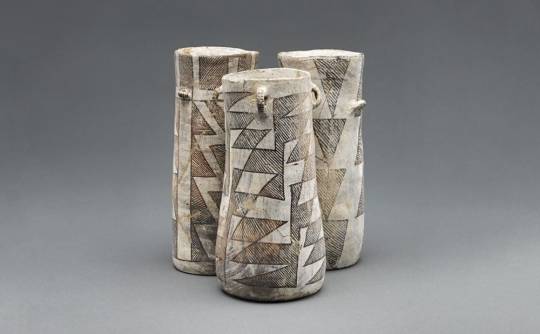
Cylinder jars for chocolate-drinking, as described and confirmed by Dr. Patricia Crown. Chaco Canyon, Pueblo Bonito, 1000-1100.
Also, Chaco Black-on-white cylinder jars were used for a chocolate-drinking ritual, indicating cultural connections, religious ties, and trade routes to Mesoamerica and Maya communities far to the south in Mexico in the 900s-1000s. It's an important thing to remember: None of these cultures or time periods were static, and were almost never insular.
Mesa Verde Black-on-white

Mesa Verde Black-on-white bowls. Southwestern Colorado/northwestern New Mexico, AD 1150-1280.
An immensely popular white ware style, Mesa Verde Black-on-white is associated with the Ancestral Pueblo settlements - including the dramatic and famous cliff dwellings, like Cliff Palace. Bold, heavy, repeating geometric designs in carbon-based paint are the most common, but there are hatched designs and some areas that used mineral paints as well. Paintbrushes to apply these painted designs were made of yucca.
Some of the most fun and famous Mesa Verde B/W vessels are the mugs of Mug House, a site so named because a bunch of mugs were found in it.
75 notes
·
View notes
Photo
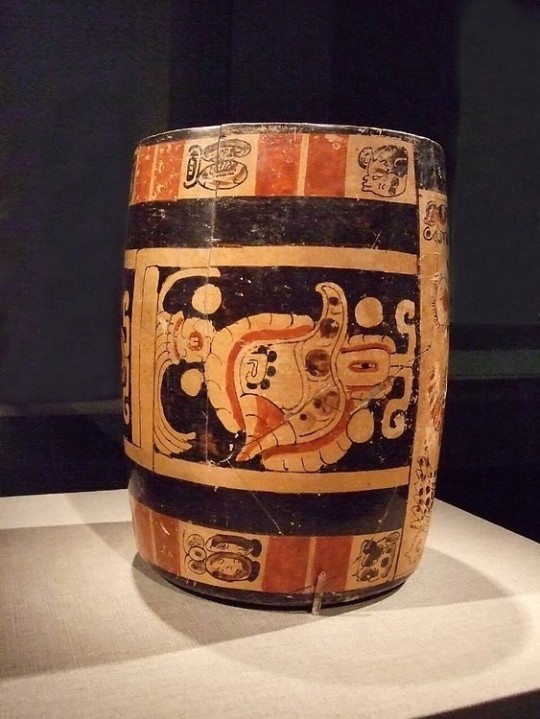
Chocolate in Mesoamerica
Chocolate was one of the most desired foods of Mesoamerica and was consumed by the Olmec, Maya, and Aztec civilizations, amongst others. Its consumption even spread via trade routes to other parts of the Americas including the Chaco Canyon in modern New Mexico. The earliest known use of chocolate was by the Olmec around 1900 BCE and, enjoyed as a drink, it was drunk from special round jars known as tecomates. The Maya used tall cylinder beakers for drinking chocolate, and these very often had text on the rim indicating their intended use. The Aztecs also had richly decorated tall cups specifically reserved for chocolate drinks. It may be that such conspicuous vessels were designed to impress onlookers that the drinker had the means and status to enjoy such a prized drink.
Cultivation & Value
Chocolate is made from the beans of cacao pods from the Theobroma cacao tree (actually native to South America) which was first cultivated in extensive orchards near the Pacific and Gulf coasts of Central America, especially in the Xoconusco region and the valleys of the Sarstoon, Polochic, and Motagua Rivers (modern Guatemala and Belize), where the tree thrives in the warm and humid climate. There were, in fact, four varieties of cacao bean or cacahuatl, as the Aztecs knew them, and the corruption of this word or their term for the chocolate drink - xocolatl - is probably the origin of the word chocolate.
So esteemed was chocolate that beans were a commonly traded item, very often demanded as tribute from subject tribes and even used as a form of currency by the Aztecs. In fact, cacao beans were so valuable that they were even counterfeited either to pass as currency or, even more fiendishly, hollowed out of their valuable interior and refilled with a substitute such as sand. As a currency, we know that in the Aztec markets one cacao bean could buy you a single tomato, 30 beans got you a rabbit and, for the more ambitious shopper, a turkey could be had for 200 beans.
As an expensive import then, chocolate was drunk mainly by the upper classes and consumed after meals, typically accompanied by the smoking of tobacco. It may have been enjoyed mixed with maize gruel by the poorer classes at important events such as weddings, but some scholars maintain that the pure chocolate drink was an exclusive status symbol of the nobility. Curiously, it could even be given to favoured sacrificial victims as a final treat before they departed this world, for example, at the annual Aztec festival of Panquetzaliztli held in honour of Huitzilopochtli.
Continue reading...
24 notes
·
View notes
Text
Heritage News of the Week
Discoveries!
During archaeological excavations in a medieval graveyard in Brahekyrkan on the Swedish island of Visingsö, archaeologists uncovered about 170 silver coins dating back to the mid-12th century. This discovery, made during a geothermal installation project at the church, not only sheds new light on the medieval history of the region, but also challenges existing notions of burial customs and coin circulation in medieval Götland.
Plato’s final hours recounted in scroll found in Vesuvius ash
Newly deciphered passages from a papyrus scroll that was buried beneath layers of volcanic ash after the AD79 eruption of Mount Vesuvius may have shed light on the final hours of Plato, a key figure in the history of western philosophy.
The discovery of Plato's burial site was part of last week's post, but I am including this story for the addition that even while dying, Plato managed to be a petty bitch.
...the ancient scroll was found to contain a previously unknown narrative detailing how the Greek philosopher spent his last evening, describing how he listened to music played on a flute by a Thracian slave girl. Despite battling a fever and being on the brink of death, Plato retained enough lucidity to critique the musician for her lack of rhythm, the account suggests.
Archaeology team discovers a 7,000-year-old and 13-hectare settlement in Serbia
Researchers have discovered a previously unknown Late Neolithic settlement near the Tamiš River in Northeast Serbia.
Bronze Age petroglyphs discovered in Kazakhstan
Volunteers in Kazakhstan have discovered new petroglyphs from the Bronze Age. The rock carvings were found by volunteers of the nationwide Taza (Clean) Kazakhstan environmental campaign in the Zhambyl region.
Ancient Pueblo used conch-shell trumpets for communication
Conch-shell trumpets have been found in burial contexts at Chaco Canyon, which today are used in contemporary Pueblo ritual practices.
3,500-year-old 'rest house' used by ancient Egyptian army discovered in Sinai desert
Egyptologists have discovered the remains of a "rest house" in the northern Sinai desert. The structure may have temporarily housed ancient Egyptian forces, and possibly even royalty, during the reign of Thutmose III, or from about 1479 to 1425 B.C.
Five skeletons found under Wolf’s Lair home of Hermann Göring in Poland
Amateur archaeologists have unearthed five human skeletons missing their hands and feet under the former home of the Nazi war criminal Hermann Göring at Hitler’s Wolf’s Lair military headquarters in present-day Poland.
Well, this is just horrible
A new chapter in the Hittite world is revealed by painted hieroglyphs discovered in the Hattusa Yerkapı tunnel
The painted hieroglyphs discovered in 2022 in the Yerkapı Tunnel in Hattusa, the capital of the Hittites, one of the first civilizations of Anatolia, were introduced at a conference held at the Culture and Promotion Consultancy of Turkey’s Embassy in Rome.
The first mother-daughter burial from the Roman period found in Austria
Modern scientific methods are increasingly uncovering spectacular results from archaeological finds dating back a long time. A grave discovered 20 years ago in Wels with the skeletons of two people and a horse has now turned out to be the first mother-daughter burial from the Roman period to be documented in Austria, according to a study by the University of Vienna.
Red squirrels spread leprosy during medieval period
A study of archaeological sites in Winchester, England, has revealed that red squirrels served as a host for Mycobacterium leprae strains that caused leprosy in people.

He may look cute - but
Unusual Maya storage pit discovered in Tulum Cave
Mexico News Daily reports that a bottle-shaped chultún, a structure usually used by the Maya to catch rainwater, has been discovered in the floor of a cave by researchers from Mexico’s National Institute of Anthropology and History (INAH).
Roman snail dye found in UK for first time
A rare dye made from snails for the robes of the Roman elite almost 2,000 years ago has been unearthed at a cricket club. The chunk of Tyrian purple, roughly the size of a ping pong ball, was dug up at Carlisle Cricket Club as part of ongoing yearly excavations.

It's so purple
Museums
The Art Gallery of Ontario (AGO), which closed to the public on March 26 as more than four hundred unionized workers went on strike, is set to reopen on April 30. The employees, whose ranks included curators, archivists, designers, researchers, technicians, and front desk staff, are represented by Local 535 of the Ontario Public Service Employees Union (OPSEU/SEFPO) and had sought wage increases and protection for part-time workers after being “hit right in the paycheck during the pandemic,” according to union president Paul Ayers. Ayers additionally pointed to a “cost-of-living crisis” as driving the action, which followed the breakdown of ten months of talks.
Mysterious Roman dodecahedron to go on display in Lincoln
They are known as one of archaeology’s great enigmas – hollow 12-sided objects from the Roman era with no known purpose or use. Only 33 of these mysterious dodecahedrons have ever been found in Britain and now one, unearthed during an amateur archaeology dig after 1,700 years underground, is going on public display in Lincoln as part of a history festival.
Revamped National Portrait Gallery among contenders for museum of the year
The National Portrait Gallery, the Manchester Museum and the Young V&A are among the contenders for this year’s museum of the year award, as institutions that have undergone extensive renovations and reappraised their collections dominate the shortlist.
Two arrested at the Musée d’Orsay for attempted damage to classified property
Two people were arrested on Sunday morning at the entrance of the Musée d’Orsay in Paris for being suspected of attempting to damage classified property. When they were arrested, they were “in possession of a white liquid – glue and a viscous whitish mixture – and were wearing flocked ‘Food Response’ t-shirts,” Le Figaro reported. The duo was also allegedly “already known for previous acts of obstructing traffic”.
Jan van Eyck’s ‘Arnolfini Portrait’ gets a new frame, polarizing social media users
It is normal for beloved artworks to get new frames every once in a while, and when they do, those frames tend not to receive much attention. But when Peter Schade, head of the National Gallery’s framing department, posted news of the van Eyck painting’s makeover, users on the social media platform X were divided on its merits.
Showing respect in the house of the dead: Australian museum removes mummified human remains
Pitkin says the Chau Chak Wing Museum is leading the world in developing and implementing new protocols surrounding the presentation of Egyptian mummified human remains. “It’s a hot topic. The academic discourse has been going on for probably ten years, but for museums to implement changes it’s been a really slow process,” Pitkin says.
Noisy, performative and unapologetically non-European: Nigeria welcomes a museum like no other
The John Randle Centre for Yoruba Culture and History, which describes itself as “a fitting symbol of the multiplicity of identities in the metropolis”, is in the Onikan area, the cultural heart of Lagos island. Unlike the National Museum, built in the late 1950s on a western model by the English archaeologist Kenneth Murray, the centre is “unapologetically Yoruba”, according to Seun Oduwole, the site’s lead architect.

Not only does it look cool as hell, it has a swimming pool
Repatriation
Monet’s Bord de Mer is currently in storage at the New Orleans Field Office of the FBI after being seized last June. The work was last sold in 2019 by New Orleans–based antiquities dealer M.S. Rau to Bridget Vita and her late husband, Kevin Schlamp, who died in March. The FBI seized the work after its research brought the work’s provenance into question.
Asante gold artefacts: Ghana rejoices as 'crown jewels' looted by British put on display
Looted artefacts from the Asante kingdom are finally on display in Ghana, 150 years after British colonisers took them.
Artifacts looted 80 years ago repatriated to Okinawa
Fragile scrolls, royal portraits, various pottery and ceramics, and a 19th-century hand-drawn map were among 22 artifacts that had been missing from the Japanese prefecture of Okinawa since they were looted following the 1945 Battle of Okinawa. Yesterday, April 30, after almost 80 years, the stolen artifacts were officially repatriated to their homeland in a ceremony held at the Okinawa Prefectural Museum and Art Museum in Naha, the Japanese island’s capital city.
Heritage at risk
Chicago-based human rights organization Justice For All has deemed the bombing of the historic Church of Saint Porphyrius in Gaza by Israel a “war crime” in a new legal filing submitted to the International Criminal Court (ICC). The group has called for an investigation in response.
Inside the exquisite Tibetan monasteries salvaged from climate change
Extreme weather is threatening these intricate 14th Century Tibetan monasteries, but local people are rising to the challenge to preserve them.
Rare editions of Pushkin are vanishing from libraries around Europe
Dozens of books have disappeared from Warsaw to Paris. The police are looking into who is taking them, and why — a tale of money, geopolitics, crafty forgers and lackluster library security.
Putin is totally stealing these, isn't he


Fakes!
You can also read the article here
Here's this year's list of the most endangered historic places in the U.S.
There's a lonely old church in the mountains of West Virginia that holds a hidden history. Black coal miners in a segregated camp worshipped there starting in the 1920s. Now, the New Salem Baptist Church is listed as one of America's 11 most endangered historic sites.
Heritage that, frankly, could stand to be at a bit more risk
Berlin’s government is offering to give away a villa once owned by Adolf Hitler’s propaganda minister, Joseph Goebbels, hoping to end a decades-long debate on whether to repurpose or bulldoze a sprawling disused site in the countryside north of the German capital.

Odds and ends
It’s important to start strong. That’s true of a lot of things in life, but doubly so when you’re an archaeologist starting off a conversation with Graham Hancock, the famed pseudoarchaeology author, in a venue such as the Joe Rogan Experience podcast. For the last decade, scholars and experts have dealt with misinformation and pseudoscience either by trying to ignore it in order not to amplify it or by debunking it once it has spread far enough. But recent misinformation research highlights the importance of prebunking rather than debunking. An audience primed with real facts is armed to understand the issues with pseudoscientific narratives.
Dorset auction house withdraws Egyptian human skulls from sale
An auction house has withdrawn 18 ancient Egyptian human skulls from sale after an MP said selling them would perpetuate the atrocities of colonialism. Bell Ribeiro-Addy, the chair of the all-party parliamentary group on Afrikan reparations, believes the sale of human remains for any purposes should be outlawed, adding that the trade was “a gross violation of human dignity”. The skulls of 10 men, five women, and three people of uncertain sex, were listed by Semley Auctioneers in Dorset, with a guide price of £200-300 for each lot.
New insights into origins of the Stone of Scone
According to a new study to understand the origins, researchers have determined that the Stone of Scone was quarried from the Scone area, and may have originally been used in a nearby church or even a Roman building. The level of wear on the top surface indicates that the stone was likely a step, predating the inauguration ceremonies and reign of Edward I.
Way back in 2000 I was in Britain for a cousin's wedding, and afterwards my mum and I travelled about Scotland for a bit, and it was while in Edinburgh Castle, in the chamber that held the Honours of Scotland and the Stone of Scone, that my mum (a proud Scot) very casually says, "You know that's not the real stone, right?". So I'm like, "oh?", and she explains that the Stone would have been carved, and the Scots knew Edward was coming, so they made a substitution, which...makes sense? I mean, the current Stone is literally a chunk of sandstone with a cross crudely carved into one side. It's really anticlimactic to look at.
Anyway, this is my mother right now

Ruined centuries-old town re-emerges as Philippines dam dries up during heatwave
After a long spell of intense heat and little rain, water levels have fallen to reveal parts of a sunken church, tombstones and foundations at Pantabangan

‘Unlike anything today’: Gippsland fossil unlocks secrets of kangaroo that died out 46,000 years ago
The fossil is one of the most intact skeletons of an extinct animal found in Australia, and the most complete skeleton found in a Victorian cave. It retained 71% of the animal’s bones, only missing small parts of the paws.

12 notes
·
View notes
Text
Chaco Canyon was incredibly remote. Kermit drove in on ten miles of very rough and rocky dirt roads. He was mad at his GPS taking him the back way, only to later discover the other road into the canyon was even worse!
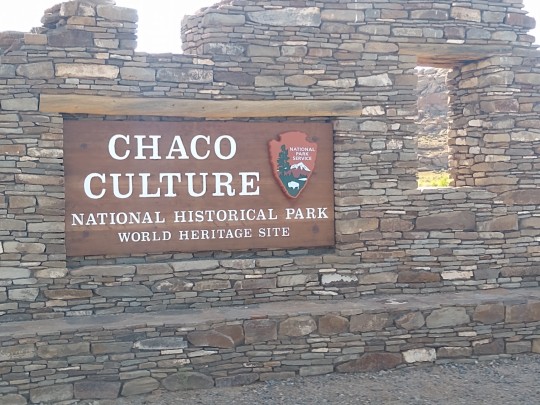
He stayed the night in the campground. In the morning he did the loop drive to see all the ancient long houses, which had been reconstructed by an archeological team in the 1890s.
At the visitor center he learned that the Chacoans lived all over the state! From 900-1200 AD they seemed to be a trading hub--archaeologists uncovered fragments of cocoa beans from South America, exotic dyes, and even macaw bones! People must have traveled thousands of miles to this canyon in New Mexico to trade with the Choacans.
At the Park Ranger's advice, he did the six mile Pueblo Alto Loop hike, which took him rock scrambling up the cliff walls to the top of the bluffs, where he could see the ruins better than anyone on the ground.


The hike was incredibly strenuous because of how much the trail dipped and climbed. The trail was marked mostly only by rock cairns, so it was easy to lose the path. At one point, the path required Kermit to scale the miniscule space between two boulders, wide enough only for one foot at a time.
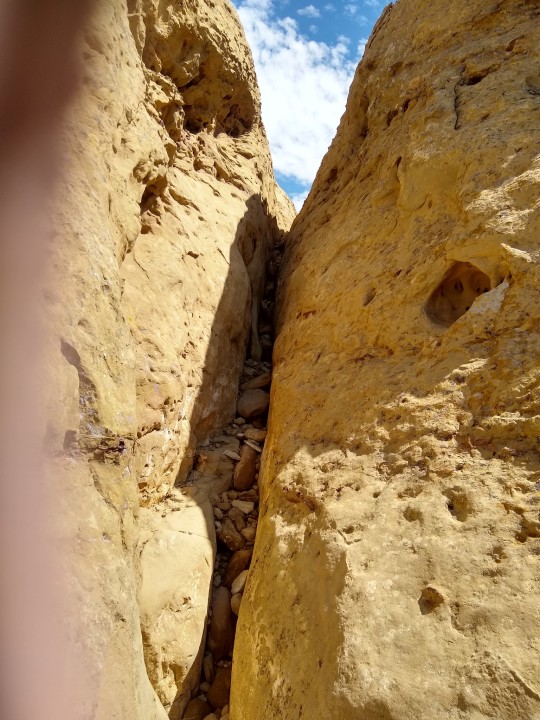
Eventually he came to one of the coolest sights in the park: ancient Chacoan stairs carved into the cliff face! Apparently the Chacoans preferred to go over obstacles as opposed to around. Imagine them climbing up and down these stairs with baskets of trade goods strapped to their backs!
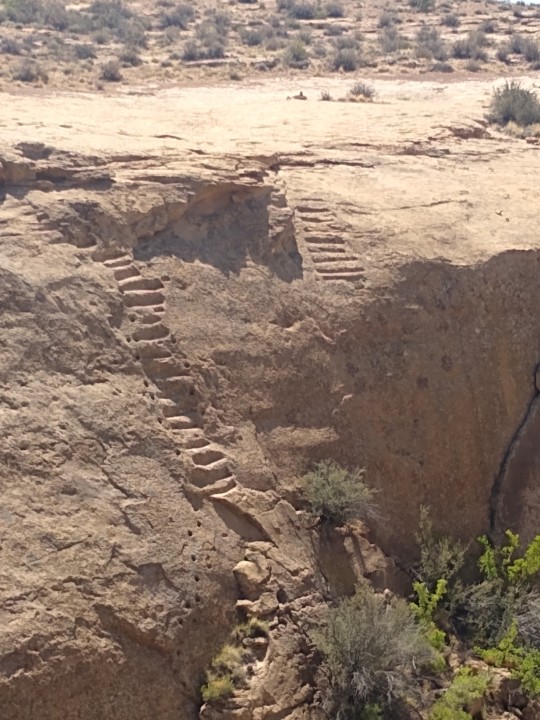
After the stairs, Kermit came to another ruin, which hikers were allowed to walk around in. The doors were very small, only a few feet high. According to Kermit's guide at Canyon De Chelly (more on that later), ancestral Puebloans were only a little more than five feet tall!
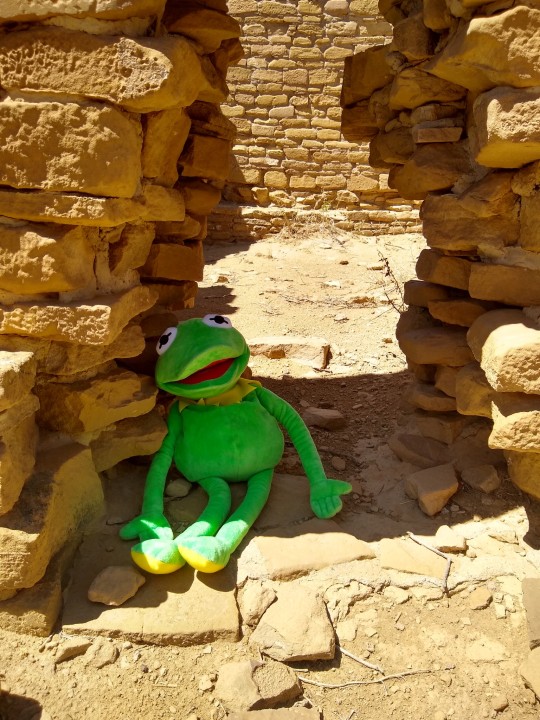
Kermit also passed a number of strange formations in the rock. Millions of years ago the entire valley was covered by water. These are old, fossilized shrimp burrows!
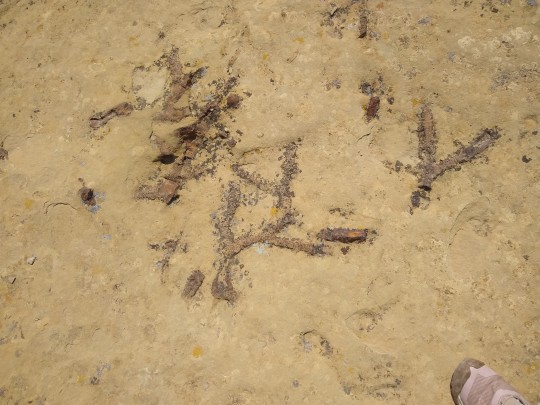
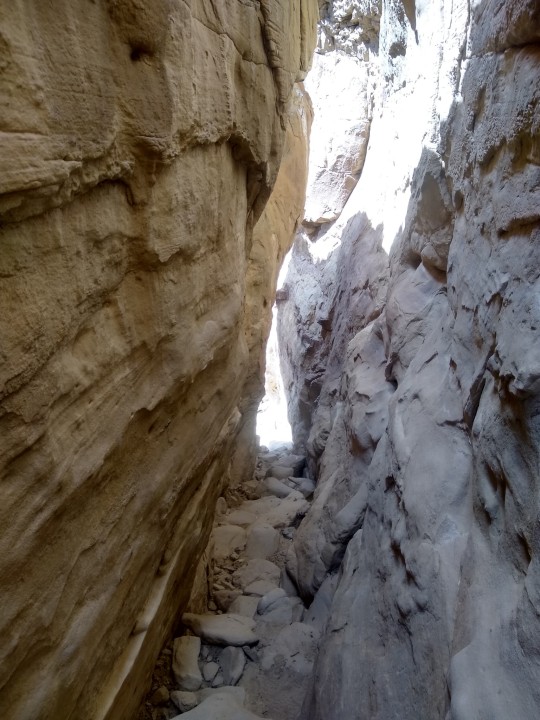
Finally, Kermit hiked back down, scrambling over boulders and between two massive rocks. It was time to leave the park, and he was so exhausted from hiking in the heat the he wanted to do nothing more than lay down in his car. His legs felt like jelly!
4 notes
·
View notes
Text
The Magnificent Five
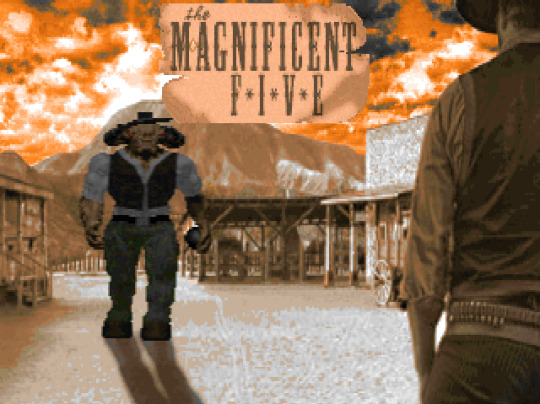
DBP30: The Magnificent Five is a 5-level (plus one credits map) Doom wad developed by the Doomer Boards, with a western theme. It uses assets from previous Western-themed mods like Boot Hill and A Fistful of Doom but is a little more expansive than either of those.
For a more comprehensive overview of this Doom mapset and similar western-themed Doom mods, please go here.
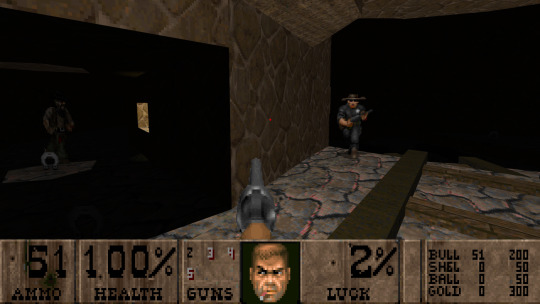
MAP01: Sunrise (Ilya "joe-ilya" Lazarev) Joe-ilya starts us off light with “Sunrise” — a tiny little two-room inn and a saloon across the way, near a small network of mine tunnels, which pose the most danger as they’re pretty dark. I never did work out how to get the armor out of the well.
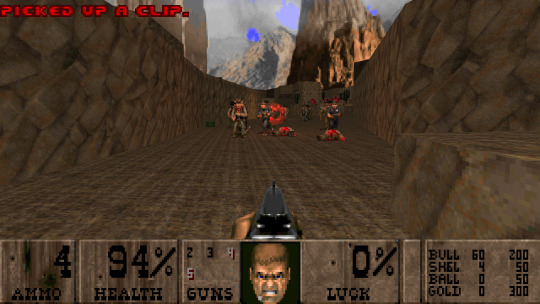
MAP02: Tempio el Diablo (Walter "daimon" Confalonieri) If the low-level skirmishing of the previous map didn’t wake you up, Walter “daimon” Confalonieri gives you a swift kick in the pants as a sprawling canyon full of enemies blocks your path to some kind of corrupted monastery. And if that’s not bad enough, on UV at least you’ll face off against a Cyberdemon, though given the theme he’s less of a cyborg and more of a really big demonic cowboy who throws cannonballs at you.
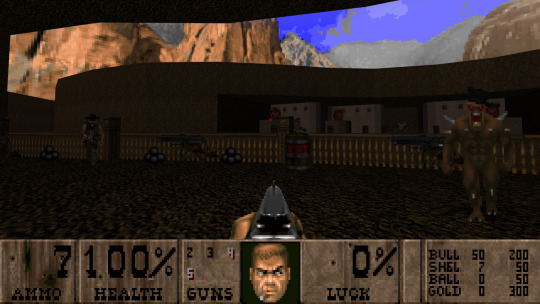
MAP03: Chaco Canyon (Micah "Jaws in Space" Petersen) "Chaco Canyon" is probably my favorite of the set, a cute little adobe village set into the walls of a canyon. You start off near a small lake and must fight your way up, tier by tier, to reach the exit. The biggest roadblock is the line of mancubi across the canyon providing artillery support, making clearing out the penultimate room a dangerous proposition.

MAP04: Assault on Rio Lobo (Jaws in Space, Morpheus Kitami) Jaws in Space and Morpheus Kitami collaborate to throw everything they’ve got at you in “Assault on Rio Lobo,” an absolute clusterfuck of an invasion map that gives you an opportunity to load up before kicking things off. After the initial massacre you’ll need to find your way up on the cliff to get the key, at which point not one but two Archviles appear to start undoing your hard work. As the shitshow reaches its climax, it’s almost safer to just make a run for the exit.
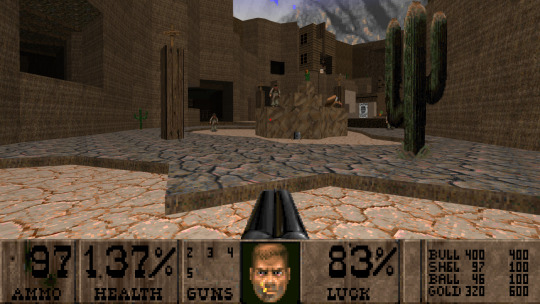
MAP05: Corbucci (LunchLunch) After the chaos of the previous map, LunchLunch’s “Corbucci” (nice) makes for a more sedate finale, despite its relatively high monster count. It’s a straightforward adventure map that has you working your way through an infested canyon-and-tunnel complex. The invisibility sphere is tempting, but it might be better saved for before you open the blue door to give yourself an edge over the ambush waiting behind.
Final thoughts: Not the biggest DBP to ever hit the internet, nor is it really the hardest, but it's a solid 60 to 90 minutes of action.
0 notes
Text
I wanna talk about the Salmon Ruins
I really can't explain in a way that doesn't make me sound like a raving lunatic how cool the cultural and chronological differences in architecture of a specific region are. Like. That sentence. Read it back? Sounds fuckin crazy. Why do I care about this? idk. I just think it's neat.
So.
Salmon Ruins. Really, I'd never heard of these ruins before I really started learning more about ancestral Puebloan (and specifically Chacoan) architecture.
Yeah, I'll be completely fucking honest, my reasons for getting into Chacoan architecture are dumb at best. At best. I'd have to trace back so many things. What led me to the Salmon Ruins? Probably, I think it started by joining a tour group that I did not pay for in Mesa Verde.
I'm 90% sure the tour guide knew I wasn't in his group, but what was he gonna do? Tell me to go away? Nah. So I tagged along because it was interesting. This tour was about the mesa part of Mesa Verde - not the cliff dwellings - mostly focusing on the early settlements and kivas. I'd been to the Manitou Cliff Dwellings as a kid, back when they called the ancestral Peubloans 'the Anasazi'. It was cool, but didn't really spark my interest outside of being there. But kivas?
I'd never heard of these things before. And there were so many! And so deep! How they were built, how they were used, who inhabited them, all new information to me. I'm sure they talked about it at the Manitou Cliff Dwellings but, ya know, you don't listen to that stuff as a kid.
Mesa Verde led me to Chaco Canyon. And Chaco Canyon (while terrifying to get in and out of) is beautiful. You could pick a 5x5 part of the outer wall of that site to study for an entire day.
The Chacoans cared about their buildings. They made art with their homes. This was beyond necessity, this was purposeful. And it was so close I could literally touch it. I could walk in the city and see what they saw from the same place they saw it. I could go on about Chaco Canyon (as I have in the past), but moving on.
Chaco Canyon led to Canyon of the Ancients, lead to Aztec Ruins, and then finally to the Salmon Ruins. Mind you - there are more sites that I haven't seen yet. They are scattered across New Mexico, Arizona, and Colorado, literally dozens of sites. I've probably seen more than most, but I've certainly not seen all of them.
But the Salmon Ruins are special in their own way, and that comes specifically from their research library. When you enter the site, they'll hand you a little laminated booklet that you return to the front office after seeing the site. That includes a map of the full site, a detailed history of its re-discovery and preservation, and most importantly - a color guide to take you to each important marker placed in the ruins.
This guide is gorgeous. The amount of information you get as you go is just amazing. It goes over common practices, tools, room usages, inhabitants, changes to the structure, everything. Personally, I found Markers 1 and 16 most interesting.
These focus on the craftsmanship specific to the people living there at the times they occupied Salmon Pueblo. Because you can tell! Who was living there! Based off how they built and rebuilt things!
Fascinating!!!!
The Chacoans used very geometrically similar rocks - think almost brick-like, cut to fit - to create the outer layer of their walls, while filling the insides of the walls with large, unshaped stones (Chacoan style core and veneer masonry). They would also decorate their walls by taking these stones and exposing them to heat to change their colors (because again!! The Chacoans!! Made their homes into art!!)
This style of masonry is not shared among all ancestral Puebloans, and when the Chacoans no longer inhabited Salmon Pueblo, other ancestral Peubloans occupied it and modifications to its structure were made in a different style, with large river rocks held together with mortar.
You can follow the Chacoans and their influence to every site they created and interacted with, including Mesa Verde and Chimney Rock in Colorado.
Idk. Maybe at some point I'm going to buy a big ole fuckin ream of paper and spread it out around my house so I can draw out and fully appreciate the chronological and geological changes and dispersion of Chacoan architecture. Maybe at some point I'll hit that level of out to lunch that it will seem like a good idea to do that.
Maybe I'm actively thinking about doing this.
Maybe I went and bought a copy of the booklet you can walk around the Salmon Ruins with. Maybe I specifically asked for one after I was done looking around.
#who knows?#the dumbest shit in the weirdest places#chaco culture#chaco canyon#ancestral peubloans#mits did you just write an entire post to talk about really old walls? MAYBE
1 note
·
View note
Text
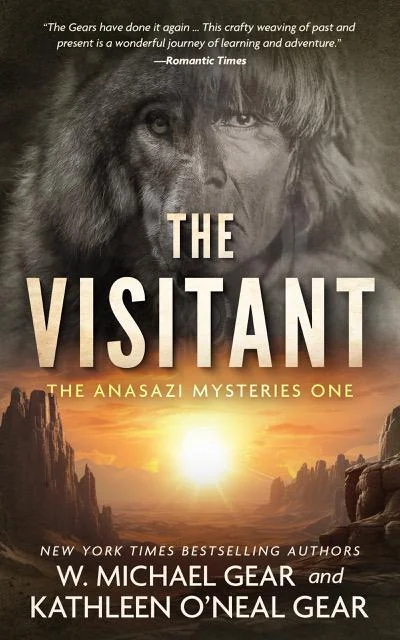
The Visitant: A Native American Historical Mystery Series (The Anasazi Mysteries Book 1)
by W. Michael Gear , Kathleen O’Neal Gear
Publisher : Wolfpack Publishing (October 10, 2023)
ASIN : B0CHLDLV5P
This is a reprint of the original The Visitant book. It has been split into two books with the next part titled, Where the Basilisk Dreams: A Native American Historical Mystery Series (The Anasazi Mysteries Book 2).
Based on an actual mysterious anomaly that may change our understanding of Southwestern archaeology. The book shows the struggle of not only prehistory, but of anthropologists and archaeologists that attempt to clarify the past from partial clues and limited authentic and verified finds. It is a split time story, bouncing from chapter to chapter from Modern archeological digs in the wonderful, mysterious, and enchanting Chaco Canyon, and the fictional prehistoric occurrences that could have produced the finds the archeologists are recovering.
The prehistoric fictional story is very frightening, and awe inspiring. Showing that in history we remember things better than what happened before. The fictional characters are attempting to reconnect with the forefathers on a spiritual journey, but find that evil is not far away. The mystery of their time is terrifying, and so carnal, and repulsive, it makes each chapter more riveting.
The characters Maureen and Dusty are some of the fans favorite characters. I like that a new audience will find these two characters in the elements as they struggle to rectify and understand the astounding artifacts they find in their modern digs. They show the difficulties of politics, ideological and cultural problems that plague archeology in the modern age. This book shows the difficulties that modern archeologists have with laws, and regulations that can be very tricky and have various repercussions. Archaeology, although regulated, is not simply cut and dry.
I have finally, in re-reading this book, seen that Dusty and Maureen do not stand in for Mike and Kathy at all. I was surprised that my memory of the characters had lightened and amalgamated their personality into these two authors that I personally admire and adore.
#The Anasazi mysteries#the visitant#Reprint#w. michael gear and kathleen o'neal gear#Dusty#Maureen#Chaco canyon#archeology
0 notes
Text

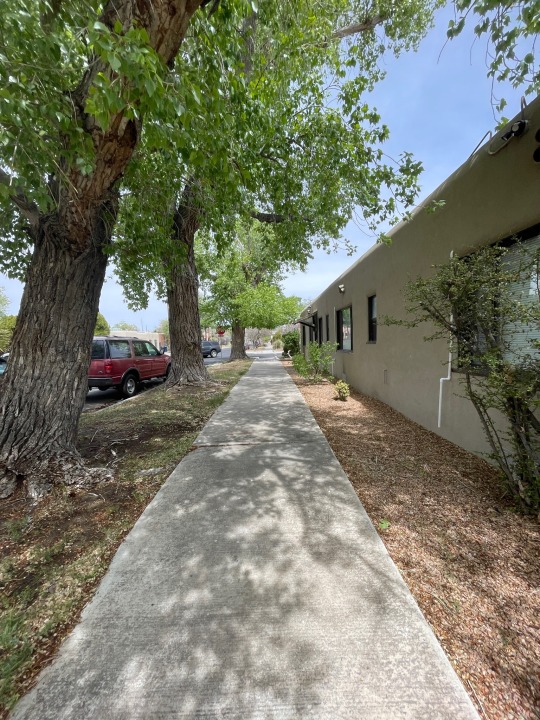

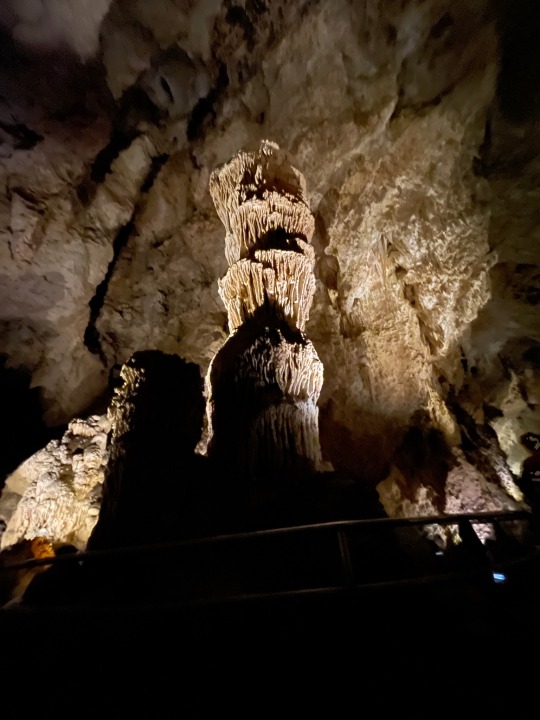
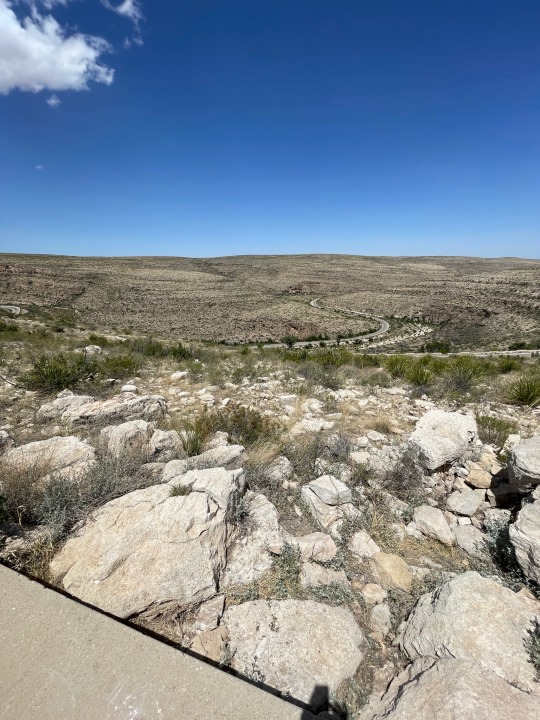
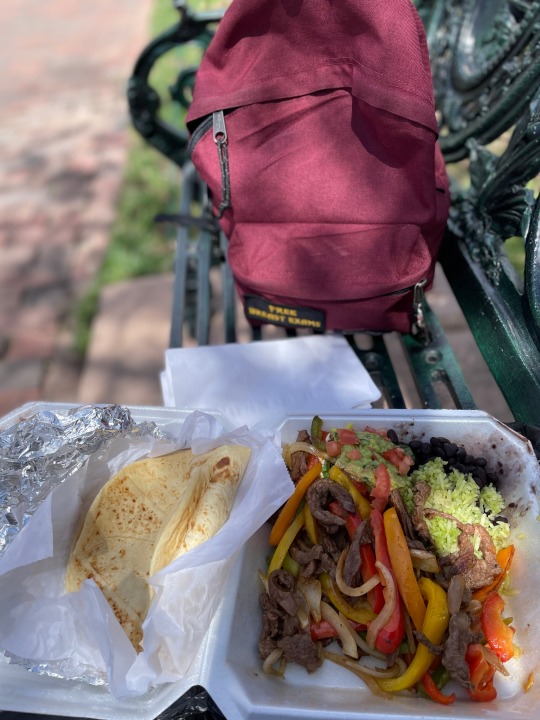
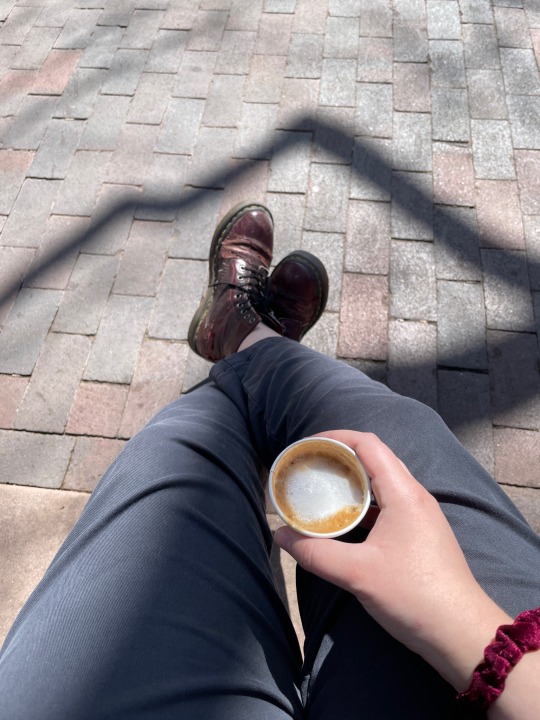

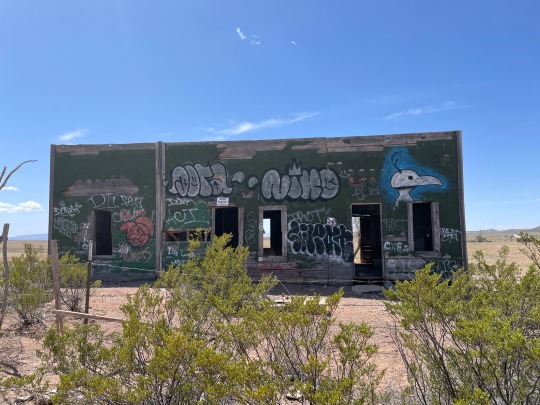

big news everybody. life is full of beauty and worth living
#kenposting#vacationposting#dats me at the bottom also :) my gfar took that! he says he’s not an artistic person but he’s really good at photos#places are: las cruces. albuquerque. 380 east. carlsbad. carlsbad again. santa fe. santa fe again. truth or consequences. 380 east again#and finally: chaco canyon
23 notes
·
View notes
Text
Leaders of the Navajo Nation, a federally-recognized tribe in the southwest, are heavily criticizing the Biden administration for its action last week banning oil and gas leasing impacting their citizens.
In a highly-anticipated action last week, Interior Secretary Deb Haaland finalized a ban on fossil fuel leasing within 10 miles of the Chaco Culture National Historical Park located near San Juan County, New Mexico. While she said the move would protect the sacred and culturally significant site, Navajo leaders have argued it will wreak economic devastation on tribal members who rely on leasing the land for income.
"I really am emotionally distraught for our constituents that have been impacted by this," Brenda Jesus, who chairs Navajo Nation Council's Resources & Development Committee, told Fox News Digital in an interview.
"Since I've entered the legislative body for my Navajo people, I've listened to a lot of constituents out in that area and, you know, it's just emotional distress, psychologically as well, that they've talked about this – it really disturbs me to know how much more of a hardship that these folks are going to be experiencing out there," she said.
On Wednesday, Jesus led a delegation of Navajo tribal leaders who met with lawmakers on Capitol Hill, making their case against the Department of the Interior's (DOI) action and for a compromise solution. The tribe previously backed a five-mile buffer zone to protect the site while ensuring future drilling on oil-rich allotments.
Navajo Nation leaders have also warned that the federal government failed to properly consult them on the action. They said Haaland never seriously considered their compromise solution and potentially neglected her legal duty to protect rights of Navajo allottees.
"The proper government-to-government tribal consultation has never really taken place at all," Jesus told Fox News Digital. "We're just really advocating on behalf of our constituents. That wasn't really considered – tribal sovereignty."
BIDEN ADMIN HIT WITH LAWSUITS FOR HIDING COMMUNICATIONS INVOLVING CABINET SECRETARY’S DAUGHTER
Overall, the ban amounts to a withdrawal of approximately 336,404 acres of public lands from mineral leasing near Chaco Canyon site.
There are currently 53 Indian allotments located in the so-called 10-mile buffer zone around Chaco Canyon, generating $6.2 million per year in royalties for an estimated 5,462 allottees, according to Navajo Nation data. In addition, there are 418 unleased allotments in the zone that are associated with 16,615 allottees.
According to the Western Energy Alliance, an industry group that represents oil and gas producers in the area, Navajo members will lose an estimated $194 million over the 20 years the action is in place.
"A lot of the allottees themselves rely on these royalties for their livelihood," Carlyle Begay, the federal and state government affairs adviser for the Navajo Nation Council, told Fox News Digital. "Instead of providing our communities and these people directly the opportunity to provide for themselves, they are providing no solutions in how these families are going to compensate for these income losses."
In addition, Navajo Nation President Buu Nygren blasted Haaland for announcing the leasing ban on Treaty Day, which celebrates the signing of the 1868 treaty that formally began the government-to-government relationship between U.S. and the Navajo Nation.
"The Secretary’s action undermines our sovereignty and self-determination," Nygren said in a statement. "Despite my concerns and denunciation, the Department of Interior has moved forward, which is highly disappointing. Secretary Haaland’s decision impacts Navajo allottees but also disregards the tribe’s choice to lease lands for economic development."
NATIVE AMERICAN TRIBES DEPENDENT ON FOSSIL FUEL RESOURCES RIP BIDEN ADMIN FOR DOUBLE STANDARD
He added that the decision "jeopardizes future economic opportunities" and places thousands of Navajo allottees in "dire financial constraints."
Troy Eid, a lawyer who represents Navajo Nation allottees and a former U.S. attorney who was appointed to chair the federal Indian Law and Order Commission, said his clients were prepared to file a lawsuit against Haaland over the action.
"These are among some of the poorest zip codes in the United States. The secretary has decided to steal their mineral rights and it is theft," Eid told Fox News Digital in an interview. "These are rights that were guaranteed to them by federal law in the Hoover administration and the very opening months of the Roosevelt administration – these allotments."
"This order to withdraw land in violation of a Navajo Nation compromise that has been out there for at least two and a half years to come up with a buffer zone that will work for everybody is absolutely outrageous," he continued. "The secretary chose to do this on Treaty Day, our Navajo Nation holiday. She's looking at a lawsuit that I think she's going to have to take very seriously."
While DOI stated Friday that the action won't impact existing leases or production on those leases, Eid and other opponents of the buffer zone said it would indirectly make Indian-owned allotments worthless.
Because drilling on the Navajo allotments requires horizontal crossings that pass through federal land impacted by the ban, the action effectively ends all drilling in the area, he said.
NATIVE AMERICAN TRIBE CONDEMNS BIDEN ADMIN EFFORT TO BAN OIL, GAS LEASING ON LANDS
"If they ban land development on all federal land, you can't have any more continued developments on our parcels. You wind that down, they would get lease payments for the duration of the leases that they have now, but they could no longer get royalties under what she's done," Eid told Fox News Digital.
"The bulk of the compensation that they earn right now – they, the allottees – from their mineral rights are royalties paid by the companies that are developing the oil and have been, for the most part, since the 1950s. There won't be any new development," he added. "There'll be no economic reason or ability for companies to develop the land."
The allotments date back to the early 1900s, when the federal government awarded them to Navajo citizens as a consolation when the tribe's territory was downsized.
Republican lawmakers, meanwhile, said Haaland's action was part of the Biden administration's broader climate change agenda and argued Chaco Canyon is already protected. Rep. Harriet Hageman, R-Wyo., who chairs a House panel on Indian affairs, said it represented a "taking" of tribal lands and vowed congressional action.
"This afternoon I had the opportunity to meet with Navajo tribal leaders and discuss Chaco Canyon and Secretary Haaland’s radical activist decision to create an arbitrary buffer zone around this national park," Hageman told Fox News Digital on Wednesday, "a decision that should rightfully lie with Congress, not the Department of Interior."
"This buffer amounts to a taking of Navajo land, creating economic hardship that will ultimately take money away from much-needed education, medical and infrastructure projects – an estimated $1 billion in revenue," she continued. "The secretary has made this cruel decision without ever speaking with tribal leaders or allottees. We will do whatever we can to stop this taking – whether through my subcommittee or the upcoming appropriations process."
The DOI declined to comment.
#nunyas news#that's puttin them in a pickle#gonna piss people off no matter what now#should have just left things as they were#could blame trump then I think
19 notes
·
View notes
Photo


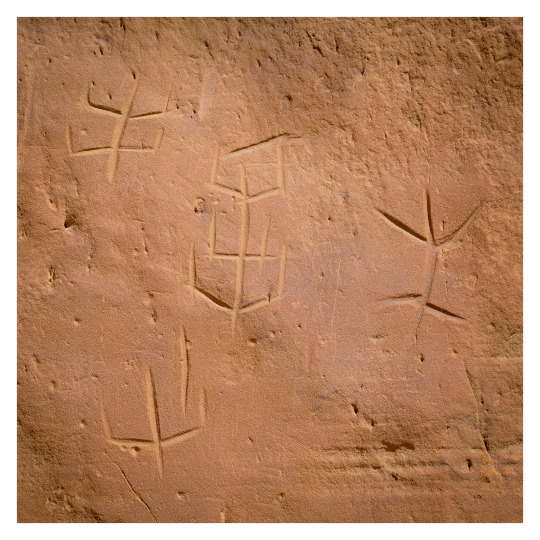




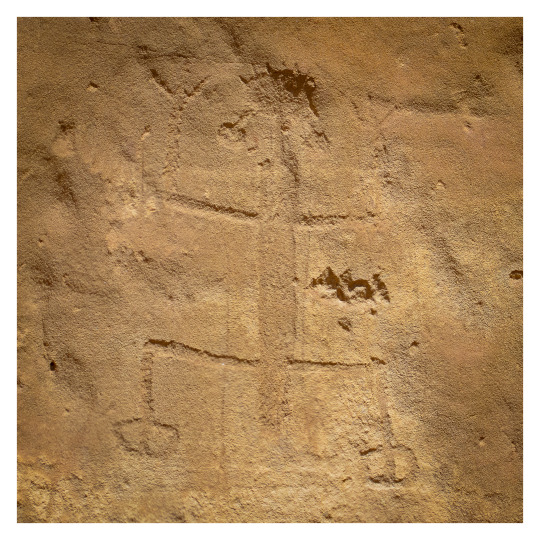
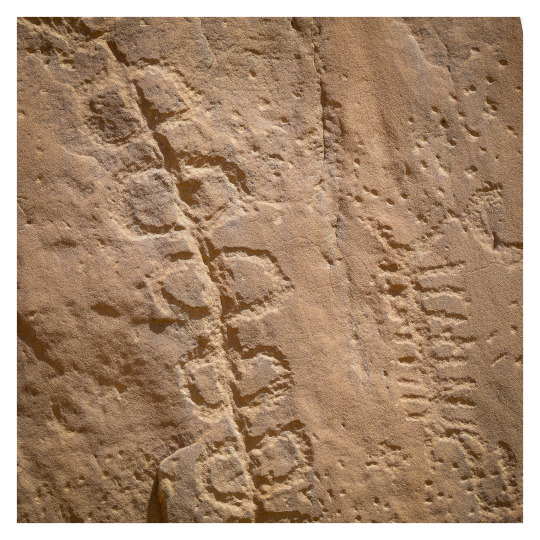
Chaco Canyon petroglyphs. These are the final photos from my recent visit to the Chaco Culture National Historical Park.
The glyphs shown here are from the canyon wall at Pueblo Bonito. There is no rock varnish here, and many of the figures were made by an unusual technique that combines both picking and deeply incising the sandstone to form the designs, as seen in the top photo.
Interpreting rock art is an uncertain undertaking, because the figures are not expressions of language or even narrative, but occasionally the ideas they represent are clear; sometimes the objects or ideas depicted by the ancient artists persist in the cultural practices of contemporary Native Americans. This kind of cultural continuity is evident in the top figure of a woman giving birth, where the woman’s hair is shown in a squash blossom whorl – a style that was routinely worn by unmarried Hopi women into the twentieth century. However old the rock art is, there are links and connections between the past and present that can sometimes be discerned.
All at the Chaco Culture National Historical Park, New Mexico. Please click any photo in the set for enlarged views.
#photographers on tumblr#petroglyphs#rock art#birthing petroglyph#squash blossom whorl#Chaco Culture National Historical Park#UNESCO World Heritage Site#Pueblo Bonito#Cliff House Sandstone#New Mexico
125 notes
·
View notes
Text
Fallout: Argentina
War.
War never changes.
As the United States and China prepared for their ultimate showdown over the last pittance of the world’s oil resources, the Justicialist Republic of Argentina clinged to the supposed golden days of the past, remaining steadfastly neutral in a world that was quickly falling apart.
But when the bombs fell, there was no such thing as neutrality. Argentina burned in atomic fire like the rest of the world. It didn’t matter if the bombs came from Washington or Beijing, as the blue skies became black and the land was poisoned by fallout.
However, before the war, the Refugio S.A. corporation managed to built, at the goverment’s request, huge vaults all over the country, that could keep generations of people alive even in the case of thermonuclear war. The Proyecto de Continuidad Nacional was supposed to keep the nation alive until it could finally arise again when the world healed itself.
Not all of these vaults were sucessful. Some were destroyed when their inhabitants went mad with claustrophobia. Others went dead when their life-support systems failed. And many opened before their due time.
The descendants of the vaults that opened now roam the radioactive Pampas, the impenetrable forests of Chaco, the howling plains of the Patagonia, the canyons of Cuyo. In the ruined cities, the crackled radios play old tangos and football matches, and canoes transport yerba mate through the Paraná, avoiding the mutated megayacarés. Gauchos might now ride terror birds and herd two-headed cows, but once again, people are living in the exterior world.
You were raised on one of the last remaining closed vaults, so you’ve only hear rumors about all these strange happenings. Some societies have arised in the new Argentina. Some are just petty gangs built on old football teams or misremembred relics of the past, but others are larger... actual goverments.... Some want to keep the past alive. Others want to make a new future in the wasteland. And yet others... think the world should’ve burned longer.
The Administrator has sent you in a mission, perhaps the most important one in centuries, to the great city of Buenos Aires -or what remains of it- to check the status of the Proyecto de Continuidad Nacional. You aren’t sure if the ancient project is still worth it or not, but what you do know is that you would do well to keep your facón and your laser pistol close to you.
Because the world might have ended. But war...
War never changes.
41 notes
·
View notes
Text
After Los Alamos, Kermit headed to Bandelier National park. Because the infrastructure of the park is so old, Kermit had to take a bus to the visitor center.


At the visitor center, a park ranger greeted them and explained some safety regulations. Because it was so hot he encouraged everyone to take a lot of water even though the hiking path to the cliff dwellings was only a few miles.
He also explained a little history about the park. Ancestral Puebloans had lived in cliff dwellings in the canyon walls around 1150 AD. The cliffs were very defensible as they were accessible only by scaling the canyon walls or by large ladders.
While the first part of the path was relatively easy, the climb up to the dwellings was more difficult. It was more than worth it, as visitors were allowed to actually climb into the cliff dwellings and walk around inside.
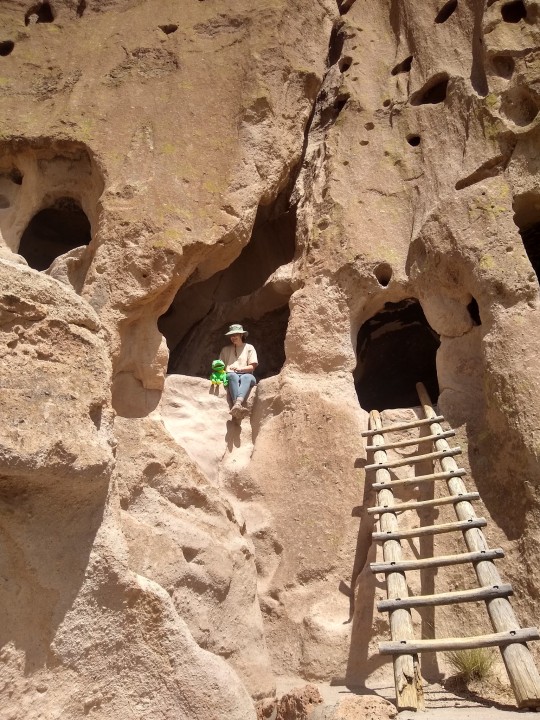
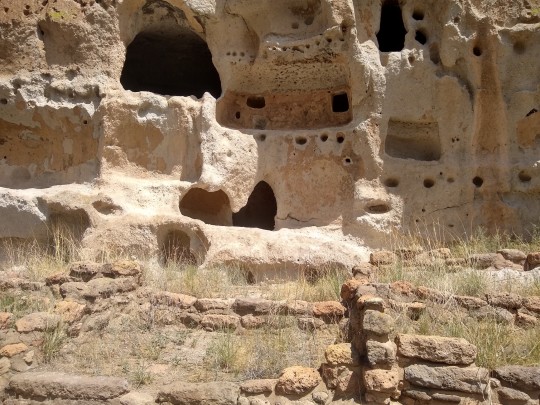
While most of the remaining dwellings were low to the ground, Kermit could see marks in the stones higher up where more dwellings existed hundreds of years ago.
The final dwelling was a *very* long climb up a series of ladders. Because the path was so thin, Kermit had to cling to the rock wall while others passed in the opposite direction.
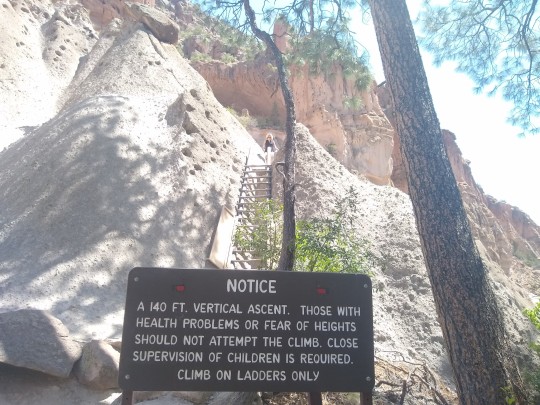
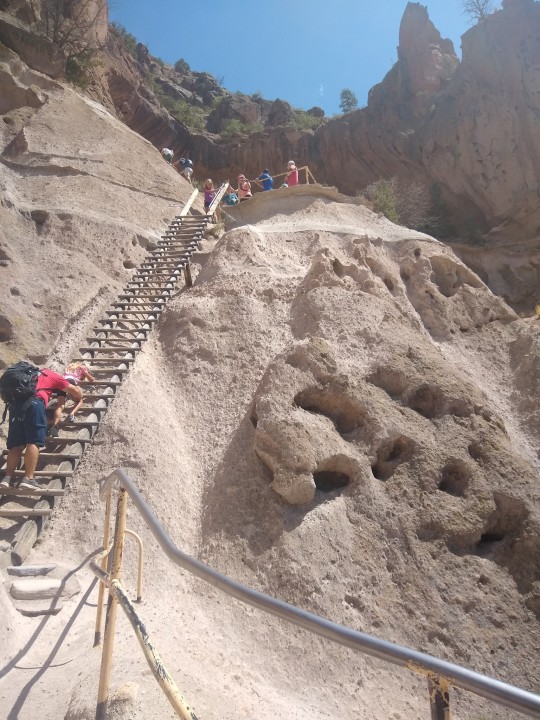
At the top of the ladder was this dwelling, which was different from the other cliff dwellings we saw!

This was a building known as a Kiva, used for ceremonies and also sometimes for living. Kermit would be travelling to two other sites where these puebloans live. Did these puebloans trade with the puebloans at Chaco canyon and Canyon de Chelly, where Kermit would be heading?
After hiking back to the visitor center, Kermit enjoyed some ice cream to cool off before heading to Chaco Canyon! (The drive was beautiful.)

3 notes
·
View notes
Text
Additions after a bit more traveling:
2 more inches of padding for my back
a souvenir box so I know where I put them
spare car key
extra caving shoes
A Packing List to Rule All Packing List
I happen to love lists, just can't get enough of them. So here! My full packing list down to the most unnecessary detail. Enjoy!
5" of mattress toppers
blankets (x3)
pillow
the Travel Rock™
face masks (x3)
little blanket
bath towel
emergency beeper
flint and steel
matches
poncho/shelter/tarp thing
craft supplies
gallon of water
emergency granola bars rations
clean clothes bag
dirty clothes bag
hat
liquid shampoo/conditioner
dry shampoo
feminine hygiene products
cotton swabs
first aid kit
extra first aid supplies (gauze/tape)
travel journal
deodorant
aloe
toothbrush/toothpaste
stuffed plush of yoda
meds
paper towels
tissues
ice scraper
microfiber sponge/towel
road flares
jumper cables
air pressure thingy
extra outfit
severe weather clothing
umbrella
ye old camping chair
shirts/pants/underwear/socks
running shoes
slip on shoes
flip flops
baby wipes
flash light
utility multitool
fire starters
batteries
taser, for funsies
headphones
hair ties/clips (x3,228)
grooming kit
phone
phone charger
car/phone charger box
car phone mount
paper map of the area
that one pebble from chaco canyon I keep forgetting about
quarters (x8)
windshield screen
wallet
travel pack/purse/carrying item
fitted sheet because I'm not an animal
extra jacket
car jack
cooler with icepacks
toilet paper
big metal water bottle
collapsible straw
glasses repair kit
backup glasses
glasses cloth
fishing supplies
compass
National Parks Pass
to-go pack of laundry detergent
rope
foil thermal blanket
my dumb ass
#i have finally removed the chaco canyon pebble! it now sits in my house#the dumbest shit in the weirdest places#packing list#traveling#travel#road trip#most of this stuff stays in my car year round so i can just take off whenever i'd like to#emergency supplies#some of these are more necessary than others btw#like#you should have jumper cables waaaaaay before you have to-go laundry detergent#some of these you should have regardless of whether or not you travel lmao#driving#road trips
11 notes
·
View notes
Text
Is Betelgeuse, One of the Sky's Brightest Stars, on the Brink of a Supernova?
https://sciencespies.com/news/is-betelgeuse-one-of-the-skys-brightest-stars-on-the-brink-of-a-supernova/
Is Betelgeuse, One of the Sky's Brightest Stars, on the Brink of a Supernova?
One of the sky’s brightest lights is losing its shine.
Since the start of December, the star Betelgeuse – the gleaming right shoulder of the constellation Orion – has been rapidly growing dim. Just 650 light-years from Earth, it’s usually the ninth most luminous star in the sky. Right now, it wouldn’t even break the top 20.
Betelgeuse is a “variable” star, known for wild fluctuations in its brightness, but scientists have never recorded it changing quite so fast. Such strange behaviour from a beloved star has them wondering: Is this a sign that Betelgeuse is about to explode?
Astronomers know that day is bound come. Betelgeuse is at least 15 times more massive than the sun and wide enough that, if we moved it to our solar system, it would extend past the orbit of Jupiter. “Supergiants” like this tend to live fast and die young, and Betelgeuse’s red colour indicates that it has already moved to one of the last stages of a star’s life: fusing helium atoms into ever-heavier elements, which it occasionally spews into space. The carbon in your cells and the oxygen in your lungs was made this way, borne across the universe on the sighs of a dying sun.
Eventually, all the material in the core will become iron – an element too heavy for further fusion. The star will succumb to the intense inward crush of its own gravity. Betelgeuse will go supernova.
“But I’m not holding my breath for it,” said Miguel Montargès, an astrophysicist at Catholic University – Leuven in Belgium.
Though Betelgeuse is near the end of its life span, it could still be as long as 100,000 years before the star begins its death throes. And although the star’s behaviour is unusual, it’s not unheard of. Stories told by aboriginal Australians suggest they observed the red star flickering hundreds, if not thousands, of years before anyone began tracking it with telescopes.
Using a suite of telescopes on a mountaintop in Chile, Montargès plans to investigate two more likely explanations for Betelgeuse’s dimming. It could be the product of gigantic convection cells inside the star that carry bright, hot material from the interior to its surface and bring cooler, darker matter back into its depths. Or it may be the result of gas clouds condensing into dust that blocks the star’s light. Both phenomena are common around red supergiant stars, and they fit with models that suggest Betelgeuse is tens of thousands of years away from exploding.
“For now, I see no reason to assume something else,” Montargès said.
Still, the scientist admitted he has a long-running New Year’s tradition of wishing for a supernova. When the clock strikes midnight on Jan. 1, he’ll be hoping 2020 will prove him wrong.
After all, no one knows the signs of an impending stellar explosion. Scientists can sometimes catch a supernova just after it happens, then search back through old images to find the star from whence it came. But the weeks and days leading up to the event are cloaked in mystery.
“We’ve never observed a star and said, ‘that star is going to die as a supernova,'” said Emily Levesque, an astronomer at the University of Washington and an expert on the life cycles of red supergiants. “That’s very much something we still need to learn.”
“I honestly think that’s why Betelgeuse is such a favourite target,” she continued. “It’s a very nearby massive star, and we know it is in the final life stage before it dies, so people have always kept one close eye on it.”
If Betelgeuse does explode, we will be treated to a light show for the ages. For a few weeks, the star would be an incredibly bright dot in our sky, glowing strong enough to be visible by day and cast shadows by night.
“No one would be able to miss it when they looked up,” Levesque said.
And once they saw it, no one would be able to forget it. Archaeological records, oral histories and written observations show that nearby supernovas leave an indelible impact on any human fortunate enough to witness them. A cave painting in New Mexico’s Chaco Canyon is thought to depict the explosion that produced the Crab nebula in 1054. Half a millennium later, when a “new and unusual” star briefly appeared in the constellation Cassiopeia, Danish astronomer Tycho Brahe proclaimed it “a miracle.”
Some scientists have suggested that nearby supernovas might do more than simply shine. The radioactive element iron-60, which is produced in huge quantities when a star explodes, has been discovered in rock layers on the ocean floor – a powerful suggestion that at least some debris from dying stars has made its way to our planet.
In 2016, in a pair of studies in the journal Nature, researchers examined these deep sea rocks in an effort to trace the iron back to supernovas. The evidence, the scientists said, points to two recent explosions happening within a few hundreds light-years of Earth; one that occurred between 6.5 and 8.7 million years ago, and another between 1.7 and 3.2 million years ago.
Coincidentally, these time frames overlap with periods when Earth’s climate shifted and its inhabitants evolved. The earlier event corresponds with the end of the Miocene, when temperatures dropped and humanity’s ancestors diverged from our chimpanzee cousins. The later one matches up to start of the last ice age and the emergence of our genus, Homo. Research suggests human evolution was prompted by climate change, and although there’s no known link between supernovas and cold temperatures, it’s conceivable that climate change could be prompted by radiation from exploding stars.
But this is largely speculation. Montargès and Levesque were both confident that an outburst from Betelgeuse, if and when it happens, will have no measurable effect on our planet. The red supergiant is not the type of star that produces high energy gamma radiation when it explodes. And it is distant enough that the only debris to reach Earth will be tiny neutrinos, detectable with none but the most sensitive scientific instruments.
If anything changes in the wake of Betelgeuse’s dimming, it will be because humans decided to change it.
Montargès knows what change he is hoping for. According to a global survey published in 2016, an estimated one-third of people on Earth today – and 80 percent of Americans – cannot view the Milky Way. Unless steps are taken to combat light pollution, billions of people will live and die without seeing stars like the ones that created almost all their atoms. They will never know the lights that inspired our ancestors’ stories, helped them tell time, pointed them in the right direction as they navigated the globe.
“The night sky is our heritage, and we’re losing our connection to it,” Montargès said. “And because we’re part of the universe, we are stardust . . . we’re losing our connection to ourselves.”
Perhaps none of us will get to see Betelgeuse go supernova. But maybe, just maybe, the fading light of this aging star can help humans find our way home.
© The Washington Post 2019
#News
4 notes
·
View notes
Photo

A thin place,” she said, “is a place where the boundary between heaven and earth is especially thin. It’s a place where we can sense the divine more readily.”
The first time I went to New Mexico I profoundly experienced a thin place.
I was camping in Chaco Canyon and during the night I heard my old Alaskan Malamute, Chena, who was with my girlfriend in Florida, howling. It was not until the next morning when I spoke to the girlfriend that I connected the howling to Chena. My girlfriend told me the precise time Chena was howling and I told her the precise time I heard a wolf howling in the Canyon. We discussed the oddness of coincidences and that there were no wolves in New Mexico at the time. She left it to coincidence, I felt it was something more. Eventually Chena passed and the relationship with the woman died as well because, as she said, she wanted more than a guy in cowboy boots who wanted to live in New Mexico.
I drove on from Chaco that day to another camp in the Grand Canyon with a hawk’s feather that had “fallen” into the plate of my mess kit during the night. Later, I was to hang that feather from my pickup truck mirror as a token reminder of permanently moving back to New Mexico to live. The feather hung on that mirror for eight years only finally disintegrating on the drive from the mortgage signing back to my granja, my small horse property, which was to ground me and be the first place I felt at home since I was a young boy.
I had many experiences of New Mexico being “a place where the boundary between heaven and earth is especially thin.” In time I came to realize that there was no place in New Mexico that that boundary was not thin. Living in New Mexico my spirit was more exercised, my prayers more powerful, my sense of peace was often overwhelming and life answers came more readily. That thin place allowed me to be more who I had believed I was and to have a sense of my place in the universe. It also allowed me to profoundly experience the other side, the mysterious side.
I was invited to attend an Apache Sunrise ceremony or na’ii’ees, the arduous 4-day puberty ceremony where a girl makes the physical and spiritual transition to a woman and takes her place in the community. The ceremony took place deep in the Mountains beyond Ruidoso on the Mescalero reservation. On the second night, with clear starlit skies and the drumbeat echoing the heartbeat of the divine, I saw the universe open as the women danced a slow solemn dance around the rim of the fire. My view shifted and I suddenly saw them dancing on the edge of a galaxy and all around me transformed into a starfield. At that moment I was part of the profundity of life in a thin place, part of the life of the Mescalero community and part of the divine.
My life in New Mexico was a series of such experiences. With those experiences, I became stronger, kinder, more confident, having a deeper sense of right and wrong, good and evil. I felt myself being clarified and all artifice being stripped away. I participated more fully in life than since I was a boy growing up in a place where I had the experience of thin places scattered in the landscape. I became truly and fully myself. I fully learned that thin places are where one becomes clarified and one sees the deepest nature of who one really is, who one was born to be and are essential if we are to find out who we really are, stripped of social expectations.
One might ask, as I often do, why I would ever leave such a place.
It is important to know that in a thin place one also meets the dark and evil side of the universe easily as well. I learned that such darkness and evil came with people and thier greed. The more people, the more greed and the more disrespect of the interface between heaven and earth. I saw such darkness and evil in abundance while I lived in New Mexico.
I lived through a small oil boom in my last few years there and saw the evil grow. The gentile poverty of the people, the emptiness of the land gave way to inflated salaries for outsiders with no respect for the place or the fact that the veil between heaven and earth was almost nonexistent. Instead the focus was on the rape of the earth and the building of a narrow wealth based on drugs and prostitution and oil and consumer goods.
Even in my beloved Santa Fe and Taos (I lived in Carlsbad) I saw the walls thicken as more rich people moved in and more greed took over. I understood that as things became very hard for me in my life in New Mexico that it was time to go. I live in Washington now and though I have chosen to live on an island in the middle of Puget Sound I find no thin places here. Too many people, too much greedy energy, too many souls focused on intellectual and political agendas other than listening to the drumbeat, the heartbeat of the universe. I occasionally think about going back. I thought about moving to Montana or Wyoming where that thinness is still available, but I saw it thickening there as well as more people crowd in. In the end I know that in their greed for the experience of the peace a thin place gives they will destroy. What they are looking for – that sense of connectedness and home that comes from a thin place requires a surrender to the life of a place and I think requires an acceptance of a non material life. They will destroy it because they will insist on bringing all the things that separated them from that peace in the first place.
I do miss the sense of home, the sense of peace and place and belonging. I have a friend here in the Seattle area who moved up from New Mexico a bit before I did, and she struggles with a profound homesickness for New Mexico. I know she could go back, just as I could and often want to, but I also know the place is changing rapidly with people from California and Texas full of themselves building lives as disconnected from heaven as they were in California and Texas.
Thin places exist only where the will of man and woman does not overwhelm the natural order of the divine. In such places there is a poverty that does not feel like poverty, a sense of community that is not artificial and defined by over thought political ideals, a silence that is so profound one can actually hear the voice of god and know that there truly is a god, not the Mosaic grandfather in the sky, though at times it can feel like that, but a profound energy flowing in the ground, the plants , the mountains, the sky and the stars. A place where all of that becomes one.
I would lie if I said I do not miss it. I miss it like I would miss my own breath if I could not breath, but I also know that it is no longer there. I saw everything thickening in the last five years I lived there. I am sure if one goes far enough into the wilderness it could still be found but by the time I left it was not the same. As I hear people here in Seattle often say, too many people. I would add, too many greedy people and confused people and lost people with an energy of despair.
I know I was blessed to find for a time in my life, the sacred and the profound. My soul still yearns for such a place. I came here to bring my life partner home and even though she says everything here has changed she seems to feel more at home.
As for me my dreams remain filled with maidens dancing on the rim of the galaxy. I hope that when my time comes to pass, I return to a thin place and find Chena and all my dogs and my horses and my friends and the peace that I found in New Mexico that passed all understanding before incomer greed overwhelmed it.
5 notes
·
View notes
Note
How will the people of my world observe that they are actually on a moon?
Tex: If we define “moon” as “a natural satellite that orbits a planet”, then the people of your world would likely find that they’re orbiting a celestial body bigger than the one they’re currently on, in much the same way that we figured out that we orbit the Sun.
Constablewrites: Well, when we got to our own moon we took a bunch of pictures of what Earth looked like from there. And there have been plenty of artists renderings about how other planets in our solar system would look in our sky if they were as close as our moon. This page has some good examples, and also some discussion of how life might be different with that setup. So things like days and seasons potentially look very different on a moon than on a planet. The question then would be if they know what things look like on a planet to recognize how their setup is different.
Synth: The simplest answer is: they look at the stuff in the sky, watch how it moves relative to their vantage point, and extrapolate from there. Eventually the mathematics of orbital mechanics will bring them to the conclusion that they orbit a planet, which in turn orbits a sun (they may or may not have determined that their sun is also a star, just much closer than all the other stars).
You haven’t mentioned anything regarding their tech level -- specifically if they’ve invented the telescope yet -- but that’s okay! Our earliest (surviving) account of a heliocentric model is from all the way back in 300 BCE, but it wasn’t until Hans Lippershey built the first known telescope in 1608, and two years later both Galileo Galilei and Simon Mayr independently were the first to see and describe the four largest moons of Jupiter, that we finally had clear evidence that Earth was not the centre of the universe. Depending on the particulars of your planetary system, your moon-dwelling populace may not even need a telescope to figure things out.
Now a longer answer, possibly probably most definitely with some digressions and general meandering, but Synth Did Research, Dammit, and learned some cool shit, so now you all get to hear about it.Okay, so, the thing is that while it may have taken humanity a good long time to definitively conclude and prove that the Earth orbits the Sun and not the other way around, we’ve been really good at tracking and calculating the motions of astronomical bodies relative to us for a long time. Like, a ludicrously long time. In 1976 a mesolithic calendar was discovered at Warren Fields in Aberdeenshire, Scotland, though excavations didn’t begin until 2004. It tracks time based on solstices. Radiocarbon dating places its construction at around 8000 BCE, over ten thousand years ago. This is just the oldest calendar we know of and/or that has survived the millennia; there could well have been more out there that are no longer intact.
Architecture with archaeoastronomical significance has been around for ages. Stonehenge in England lines up with the solstices and possibly also lunar motion. Chaco Canyon in the USA tracks solstices and equinoxes. The Governor’s Palace at the ancient Maya city of Uxmal, Yucatán Peninsula, Mexico, aligns to the movement of Venus. There are hypotheses that some of the paintings in the Lascaux caves (which are somewhere around seventeen thousand years old) in France form a paleolithic star chart. The saros cycle, the repeating pattern of solar and lunar eclipses, was known to Babylonian astronomers way back in 3500 BCE.
We have been fascinated with outer space for probably the entirety of our existence. It just took us a little while to confirm heliocentrism because from our point of reference it does look like everything else is travelling around the Earth. If your moon inhabitants have a similar level of curiosity about their surroundings, it isn’t that far a stretch to think they might also excel at mapping the stuff up in the sky, even in their equivalent of the Stone Age. And once their tech hits the computer era, well, a recent example that we tossed out into the cosmos is New Horizons. It arrived pretty much almost exactly when we calculated it would, after travelling several billion kilometres over the course of almost a decade.
Yeah, humanity has become real good at space math over the ages.
Two potentially helpful terms to look into are eclipses and (apparent) retrograde motion.
From our vantage point the apparent diameter of the Moon and the Sun is almost identical -- 31 arcminutes, or half a degree, on average -- so prior to figuring out that the Sun is in truth some four hundred times wider than the Moon but looks way smaller than that because of the distance, how could we tell that the Moon was closer to us? By observing eclipses. Sometimes the Moon comes between the Sun and the Earth (solar eclipse), and sometimes the Earth comes between the Sun and the Moon (lunar eclipse), but the Sun never comes between the Earth and the Moon (...Armaggedon?), therefore the Sun must be farther away from us than the Moon.
Apparent retrograde motion is when a planet (or moon or other celestial body) appears to move in reverse from its usual path. AKA: why Mars* be Like That.
*All the other planets in our solar system also demonstrate retrograde motion, but Mars is the closest to us that doesn’t sometimes get lost in the glare of the Sun, so it’s the easiest to track.
Explaining retrograde motion was the biggest hurdle for geocentric systems. If everything orbits the Earth, why do the other planets sometimes just turn around and go the other way for a while? Enter epicycles, many smaller circles that the planet travelled around as it moved along its orbit. When it came to explaining planetary motion and plotting future astronomical positions, epicycles… did a surprisingly decent job at it, because math reasons.
This is an almost 250-year-old diagram of the apparent motions of Mercury, Venus and the Sun as seen from Earth, and it definitely looks very epicycle-y. It’s also complicated, looking less like a map of a solar system and more like someone had a bit of fun with a Spirograph™, and it doesn’t even include the Moon, or Mars or Jupiter or Saturn, the other three planets known in antiquity. But it held on for a good long while because it did work to describe how they moved. Even Copernicus’ new heliocentric model made use of epicycles, since the circular orbits he used in it couldn’t entirely account for the planets’ observed paths. It wasn’t until Kepler came along about a century after Copernicus and postulated elliptical orbits for the planets that everything fell into place as we know it now.
A few things to consider when building your solar system.
Ratio of moon-to-planet sizes. Saturn’s moons are quite small relative to their parent planet. Our moon is very large, as moons go, at ¼ Earth’s diameter. Pluto’s moon Charon is massive compared to Pluto, at over ½ Pluto’s diameter.
Distance between moon(s) and planet, and planet and sun. You don’t need exact measurements, but if there are multiple moons you should have at least a rough overview of what order they’re in. Is your inhabited moon the closest one to the planet, or the farthest out, or somewhere in the middle? This also ties back into the sizes of your astronomical bodies, since the closer things are to each other, the larger they will appear in the sky. Is the planet an absolutely massive presence in your moon’s sky, or does it only cover a few degrees? Or not even a whole degree? How big is the sun in the sky? What about the other planets, if there are other planets? Are they only differentiated from the background stars because they move more, or are they big enough and/or close enough to be Very Obviously Not Stars?
Number of moons. Is it like Earth, with its single moon? Maybe more like Pluto, with five moons, or Neptune, with fourteen. Or perhaps even Jupiter or Saturn, at over sixty moons each and possibly more yet to be found. How many of these other moons are visible from your inhabited moon, if any? Do they all orbit relatively close to the plane of the ecliptic, or are some of them off doing their own thing, zooming around on a highly eccentric, extremely inclined orbit?
Type of planet. Does your moon orbit a rocky planet (e.g. Earth, Mars), or a gas giant (e.g. Jupiter, Uranus)? Gas giants -- or rocky planets with extreme cloud cover, like Venus -- have a higher albedo than rocky planets, meaning they reflect a greater amount of any solar radiation that shines on them. If the parent planet is very reflective, there could be a lot of sunlight shining on your moon for very long stretches of time, depending on how things orbit each other. Perhaps the moon’s inhabitants get more of their light indirectly via planetary reflection, rather than directly from the sun?
Is this moon tidally locked to its planet? This means its rotational and orbital periods sync up -- i.e. the time it takes to spin once on its axis and the time it takes to travel once around its primary are identical -- thus the same face is always pointed toward the planet. Earth’s moon is tidally locked, so we never see the back of it from down here on the ground. A tidally locked moon could make things quite interesting for the inhabitants: people living on one hemisphere would always see the planet in the sky, and people on the other side would never see it. Potential for some interesting things there.
Not astronomy-related per se, but what’s going on with your moon’s populace in a religious sense? Here on Earth religion did play a big part in how long it took for certain astronomical theories to get off the ground. Do these people have any spiritual/religious beliefs that might help or hinder the general acceptance of: “Yo, we’re on a moon”?
It’s possible that some moons might have smaller moons of their own. They’re called submoons, grandmoons, or moonmoons, because sometimes scientists are not great at naming things. If your people have made it to the “flinging stuff into space via a chain of controlled explosions (i.e. rockets)” level of technology, their moon probably has at least a few artificial satellites.
Here is a neat chart of our solar system’s moons, which I am including for inspiration purposes and also because it’s cool.
...I could have probably condensed all of that down to “eclipses and retrograde motion” and been done with it, huh? Oh well. I hope everybody learned some interesting things today.
27 notes
·
View notes